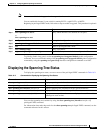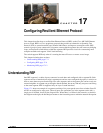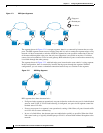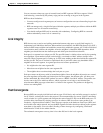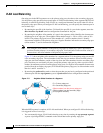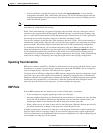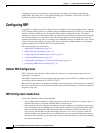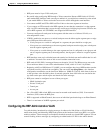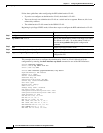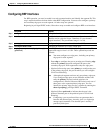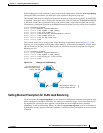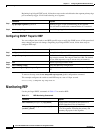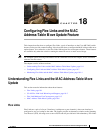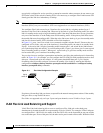
17-7
Cisco ME 3400 Ethernet Access Switch Software Configuration Guide
OL-9639-06
Chapter 17 Configuring Resilient Ethernet Protocol
Configuring REP
• REP ports must be Layer 2 ISL trunk ports.
• Be careful when configuring REP through a Telnet connection. Because REP blocks all VLANs
until another REP interface sends a message to unblock it, you might lose connectivity to the switch
if you enable REP in a Telnet session that accesses the switch through the same interface.
• You cannot run REP and STP or REP and Flex Links on the same segment or interface.
• If you connect an STP network to the REP segment, be sure that the connection is at the segment
edge. An STP connection that is not at the edge could cause a bridging loop because STP does not
run on REP segments. All STP BPDUs are dropped at REP interfaces.
• You must configure all trunk ports in the segment with the same set of allowed VLANs, or a
misconfiguration occurs.
• If REP is enabled on two ports on a switch, both ports must be either regular segment ports or edge
ports. REP ports follow these rules:
–
If only one port on a switch is configured in a segment, the port should be an edge port.
–
If two ports on a switch belong to the same segment, both ports must be edge ports or both ports
must be regular segment ports.
–
If two ports on a switch belong to the same segment and one is configured as an edge port and
one as a regular segment port (a misconfiguration), the edge port is treated as a regular segment
port.
• REP interfaces come up in a blocked state and remains in a blocked state until notified that it is safe
to unblock. You need to be aware of this to avoid sudden connection losses.
• REP sends all LSL PDUs in untagged frames on the native VLAN. The BPA message sent to the
Cisco multicast address is sent on the administration VLAN, which is VLAN 1 by default.
• Beginning with Cisco IOS Release 12.2(46)SE, you can configure how long a REP interface remains
up without receiving a hello from a neighbor. You can use the rep lsl-age-timer value interface
configuration command to set the time from 3000 ms to 10000 ms. The LSL hello timer is then set
to the age-timer value divided by three. In normal operation, three LSL hellos are sent before the
age timer on the peer switch expires and checks for hello messages.
• REP ports cannot be configured as one of these port types:
–
SPAN destination port
–
Private VLAN port
–
Tunnel port
–
Access port
• On a Cisco ME-3400 switch, REP ports must be network node interfaces (NNI). User-network
interfaces (UNIs) cannot be REP ports.
• REP is supported on EtherChannels, but not on an individual port that belongs to an EtherChannel.
• There is a maximum of 64 REP segments per switch.
Configuring the REP Administrative VLAN
To avoid the delay introduced by relaying messages in software for link-failure or VLAN-blocking
notification during load balancing, REP floods packets at the hardware flood layer (HFL) to a regular
multicast address. These messages are flooded to the whole network, not just the REP segment. You can
control flooding of these messages by configuring an administrative VLAN for the whole domain.



